England: Computer Science GCSE, AS, and A Levels
The size and shape of the secondary and primary sector[11]
| Primary (maintained) | Secondary (maintained) | |
|---|---|---|
| Schools | 16,791 | 3,458 |
| Students | 4,660,263 | 3,493,506 |
| Teachers | 221,359 | 209,824 |
There are around 620k students in each secondary year band in England.[1]
It is anticipated that primary school numbers will drop across the period to 2030, whilst secondary numbers will peak in around 2025 before the primary decline begins to have an impact.
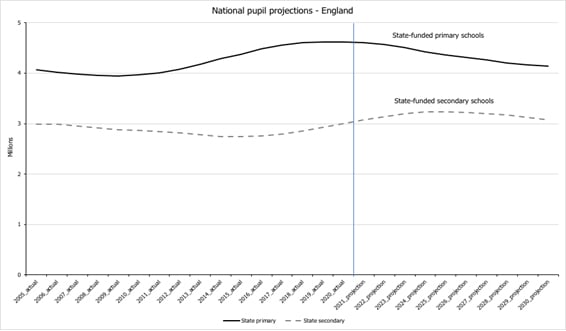
Current curriculum and assessment
This section attempts to capture in as summative a form as possible, the key characteristics of the main examinations currently available in England, including the curriculum focus, assessment methodology and coding languages preferred.
Curriculum focus:
- Fundamentals of algorithms
- Programming
- Fundamentals of data representation
- Computer systems
- Fundamentals of computer networks
- Fundamentals of cyber security
- Ethical, legal and environmental impacts of digital technology on wider society, including issues of privacy
- Aspects of software development
- Programming project
Assessment approach:
- Written examination and a 20 hour practical project.
- The project is not assessed.
Language preferred:
- C#, C++, C, Java, Pascal/Delphi, Python (versions 3 and 2), VB.Net
Curriculum focus:
- Fundamentals of programming
- Fundamentals of data structures
- Systematic approach to problem solving
- Theory of computation
- Fundamentals of data representation
- Fundamentals of computer systems
- Fundamentals of computer organisation and architecture
- Consequences of uses of computing
- Fundamentals of communication and networking
Assessment approach:
- Written and on-screen examination, including programme writing in an electronic answer format.
Language preferred:
- C#, Java, Pascal/Delphi, Python, VB.Net
Curriculum focus:
- Fundamentals of programming
- Fundamentals of data structures
- Fundamentals of algorithms
- Theory of computation
- Fundamentals of data representation
- Fundamentals of computer systems
- Fundamentals of computer organisation and architecture
- Consequences of uses of computing
- Fundamentals of communication and networking
- Fundamentals of databases
- Big Data
- Fundamentals of functional programming
- Systematic approach to problem solving
- Non-exam assessment - the computing practical project
Assessment approach:
- Written and on-screen examination and a practical project. The latter comprises 20% of the overall marks.
Language preferred:
- C#, Java, Pascal/Delphi, Python, VB.Net
Curriculum focus:
- Understanding Computer Science: hardware, logical operations, communication, data representation and data types, operating systems, principles of programming, software engineering, program construction, security, authentication and data management and the impacts of digital technology on wider society as well as algorithms and programming constructs.
- Computer Programming: problem solving, programming languages, data structures and data types, program design, implementation and testing.
Assessment approach:
- Written and on-screen examination. The latter comprises 50% of the overall marks.
Language preferred:
- One or more high-level programming language with a textual program definition, Python 3 at least.
Curriculum focus:
- Programming and System Development
- Computer Architecture, Data, Communication and Applications
- Programmed Solution to a Problem
Assessment approach:
- Written examination and a practical project. The latter comprises 20% of the overall marks.
Language preferred:
- Any high-level programming language.
Curriculum focus:
- Fundamentals of Computer Science
- Practical Programming to Solve Problems
Assessment approach:
- Written and on-screen examination. The latter comprises 30% of the qualification.
Language preferred:
- Python, Visual Basic.NET, Java
Curriculum focus:
- Systems architecture
- Memory and storage
- Computer networks, connections and protocols
- Network security
- Systems software
- Ethical, legal, cultural and environmental impacts of digital technology
- Algorithms
- Programming fundamentals
- Producing robust programs
- Boolean logic
- Programming languages and Integrated Development Environment
Assessment approach:
- Written examination.
Language preferred:
- Either the OCR Exam Reference Language or any other high-level programming language.
Curriculum focus:
- The characteristics of contemporary processors, input, output and storage devices
- Software and software development
- Exchanging data
- Data types, data structures and algorithms
- Legal, moral, cultural and ethical issues
- Elements of computational thinking
- Problem solving and programming
- Algorithms to solve problems and standard algorithms
- A computing problem to work through according to the guidance in the specification: Analysis of the problem; Design of the solution; Developing the solution; Evaluation
Assessment approach:
- Written examination and a practical project. The latter comprises 20% of the overall marks.
Language preferred:
- Python, C family of languages (for example C# C+ etc.), Java, Visual Basic, PHP, Delph
Curriculum focus:
- The characteristics of contemporary processors, input, output and storage devices
- Software and software development
- Programming
- Exchanging data
- Data types, data structures and algorithms
- Legal, moral, ethical and cultural issues
- Elements of computational thinking
- Problem solving and programming
- Algorithms
Assessment approach:
- Written examination.
Language preferred:
- None specified
Curriculum focus:
- Computational thinking
- Data
- Computers
- Networks
- Issues and impact
- Problem solving with programming
Assessment approach:
- Written and on-screen examination
Language preferred:
- Programme language subset specified.
- On-screen tasks using Python 3.
The teaching workforce
The Computer Science teaching workforce in England is growing, as the graph below shows. It also illustrates a relatively similar rate of decline in ICT teachers, with the overall number of Computer Science plus ICT teachers remaining similar to the levels of ICT teachers four years previously[13].
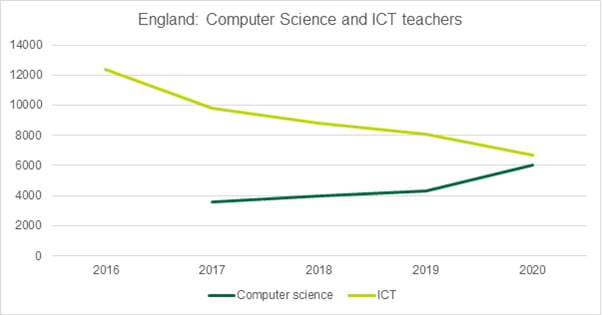
There is typically at least one designated Computer Science teacher per secondary school in England, however the available data suggests that not all schools offer the qualification so there may be a higher proportion of these specialists in schools that do offer the qualification, as outlined by Kemp and Berry[14]. This shift in teacher designation is unsurprising given the change in the GCSE.
The recruitment of computing teachers to initial teacher training/education remains a challenge, with under 75% of the target figure being met in the past five years (EE).
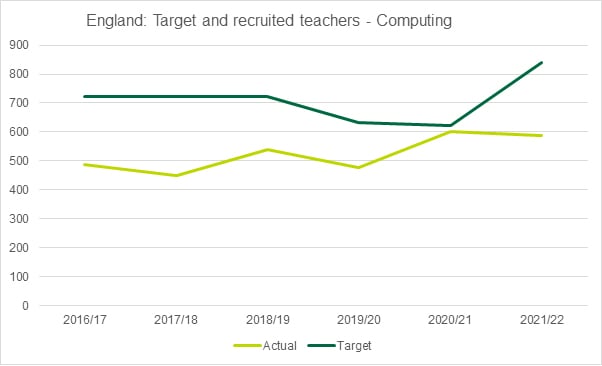
The 2021/22 Teacher Supply Model target for postgraduate initial teacher training in computing in England is 840, a notable upwards shift from the 2020/21 target of 621. This target appears to have been missed, as in each of the previous recruitment cycles. Even with 70% recruitment figure (representing 589 trainees) this is still below the previous year’s target.
The best recruitment year (2020/21) saw 97% of the target being met, but the numbers in this cycle may have been affected by the poor economic outlook and this may have been a single-year phenomenon[16]. Amongst STEM subjects, only biology recruited at a better rate, with chemistry, mathematics, and physics still some way short of the target, even though there are no recruitment limits on teacher training or education providers currently.
Recruitment to teacher training is modestly associated with both downturns in an economic cycle and precarious labour markets (ibid). Other authors[17] have been tracking the recruitment data since the 2021 cycle began and have also noted the relative upturn in interest in teaching as a career option. Training to teach Computer Science computing appears to have benefitted from this increased labour market uncertainty. However, the signals this sends about the prospects for a stable career as, say, a computer scientist may suffer as a result, influencing young people’s views of the attractiveness of the subject.
The upturn may also reflect a ‘slow-burn’ success of the introduction of incentives such as training bursaries of £24,000 and scholarships of an additional £2,000 which also attract expert support from BCS[18]. Bursary support can be a useful way of boosting recruitment, however previous efforts in other priority subjects have sometimes resulted in ‘bursary tourism’ (where trainees take up a bursary, train, and do not teach, or are recruited to the independent sector)[19]. In a further step, highlighting the ongoing challenge involved in securing sufficient new entrants, recruitment to teacher training/education has also been encouraged by offering to repay student loans[20].
Potential trainees can supplement their knowledge by undertaking one of the 27 subject knowledge enhancement courses available across England, prior to starting their initial teacher training/education (ITT/E) programme[21].
To complement the work carried out by the Computing as School (CAS) network[2] there has been a significant increase in the professional development available for computing teachers in English secondary schools, and for those who wish to develop the specialism as an additional subject.
The launch of the National Centre for Computing Education (NCCE) in 2018 which includes the Teach Computing[3] programme (including bursaries for teachers to support training) offers a way to make up the shortfall in computing teaching skills at every key stage in England. NCCE recently announced that it has supported over 30,000 teachers including over 5,800 secondary specialists to support GCSE Computer Science teaching[4]. The NCCE is currently on track to meet its targeted number of these specialists.
Teacher subject specialism courses were introduced in England in 2016[22], aimed at non-specialists and returning teachers in secondary mathematics, core maths, physics, and modern foreign languages (MFL). They do not currently include Computing.
Attainment and participation
The withdrawal of the GCSE in ICT resulted, inevitably, in its decline in the attainment data. There were no entries in 2017/18 and a very small number of entries for AS level and A level in 2018/19. The following charts set out the patterns of participation over the past five years. For the sake of comparison, data for England, Northern Ireland, and Wales is drawn from the Joint Council for Qualifications (JCQ) annual statistical bulletins.
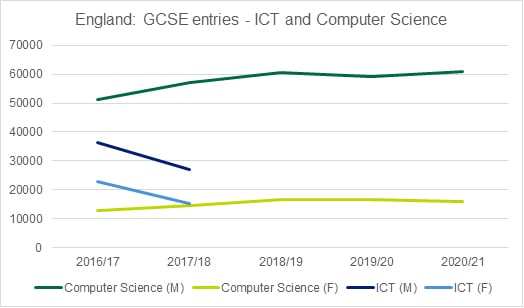
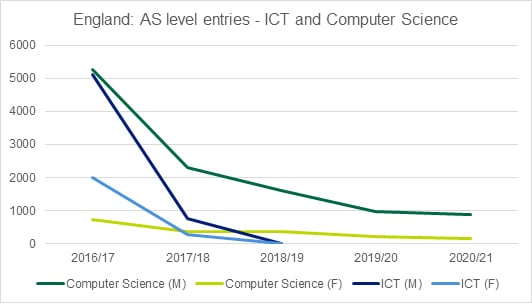
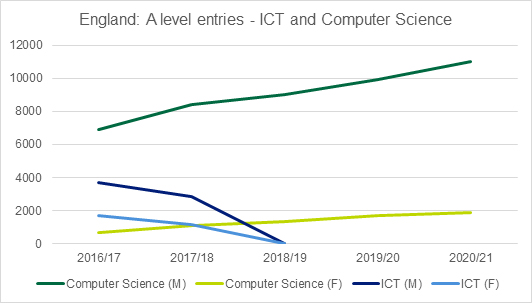
When comparing the attainment of female and male candidates across GCSE, AS and A levels over the past five years (as in the following charts), at the highest grades, female candidates appear to regularly outperform male candidates. However, there appears to be a plateau in entries at GCSE, and a much slower rate of growth in uptake at A level by female candidates compared with males.
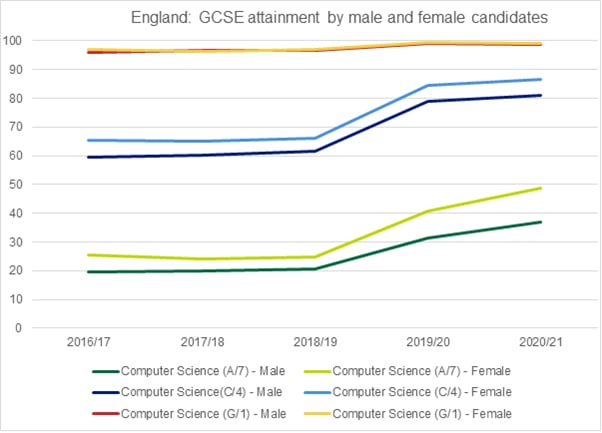
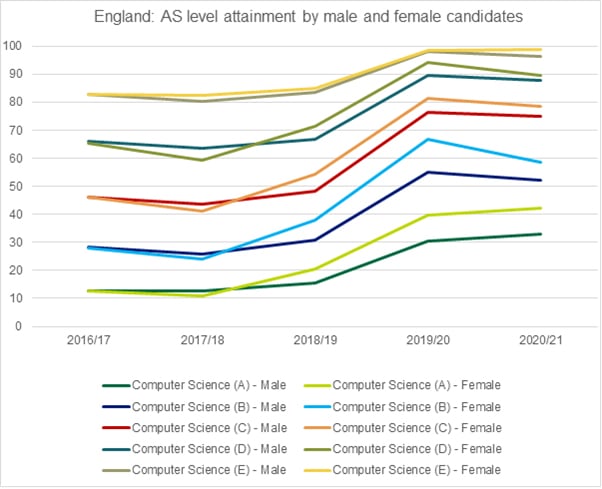
Studying Computer Science has rapidly increased at KS4 and KS5, but this growth appears to be slowing and about 78% of schools in England offer the GCSE.
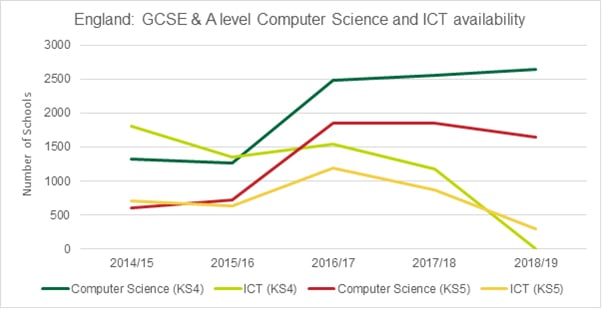
The new computing curriculum has been taken up rapidly and more schools now offer GCSE and A level Computer Science than offered GCSE and A level ICT. The position of AS levels in England has changed from being part of a progression to A level to being a stand-alone examination, with a concomitant decline in school and student interest. The inclusion of GCSE Computer Science in the English Baccalaureate (EBacc) measure of school performance may have generated initial interest in the qualification.
In 2020, Computer Science was ranked as:
- 16th most popular GCSE with 13.4% of the cohort taking the examination
- 18th most popular A level with 6% of the cohort taking the examination
- At both A level and GCSE, it is the least popular of the four main sciences, with there being twice as many Physics GCSE entrants and three times as many A level Physics entrants
These patterns conceal some stark disparities in uptake by gender, patterns that were already evident in the previous GCSE participation rates, but which are now more dramatic. Whilst previously the male:female student ratio in ICT participation at GCSE, AS level and A level, ran at 2-3:1, for Computer Science this has remained at 4:1 for GCSE and it has been as high as 10:1 for A level (6:1 in 2019/20).
There is no public and accessible published data regarding uptake by ethnicity, although Kemp, Berry, and Wong[23] used the National Pupil Database (NPD) to examine this and found that the diversity of entrants to Computer Science (compared with ICT) was markedly different and not as representative as would be desired[5]. The same authors have recently reiterated their concerns about the unrepresentative nature of entries for the Computer Science GCSE in England, with particular concerns over female student participation[24].
Some of the uptake challenges appear to be rooted in perception issues, both for students and parents/carers. The Department for Education (DfE) regularly surveys the subject choice views of students and their parents / carers[25].
The latest DfE survey from summer 2019 says:
- GCSE Computer Science was the least popular choice (out of Foreign Languages, Arts, Design and technology, Humanities, and Computer Science).
- 23% of students were aiming to pursue Computer Science, compared with 74% for the Humanities subjects
- Almost three-times as many males students as female students were planning to take the subject. Whilst a substantial element of those rejecting GCSE Computer Science (62%) said that they did not enjoy the subject, male students tended to opt for the subject because they did enjoy it
- Female students reported that they were more likely than their male counterparts to opt for GCSE Computer Science as their schools insisted upon it
- Parents and carers were less likely to discuss careers in Computer Science with their children, however they were enthusiastic about the subject and, when presented with options, were highly likely to recommend it to their children
- Students also recognised that (in spite of overall negative perceptions) that a qualification in Computer Science would be an asset for future career / job prospects (compared with the other subjects listed above) possibly due to gaps in their understanding of what careers are possible
The involvement of parents and carers in supporting choices was also highlighted in a recent report examining how interventions aimed at altering behaviour relating to subject choices influenced A-level selection[26]. The interventions were targeted at improving the participation of high-attaining female students in STEM subjects (including Computer Science) prior to finally selecting their A levels. Whilst there was little evidence of an impact at individual subject level, students in the intervention group whose parents or carers were ‘nudged’ were more likely to select a second STEM subject.
There is currently no published data illustrating uptake by students by socioeconomic status, ethnicity or other relevant demographic. This can only be accessed via the NPD.








